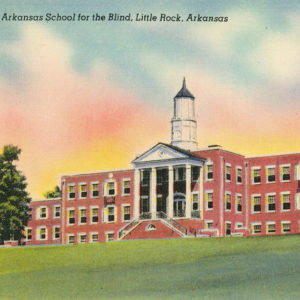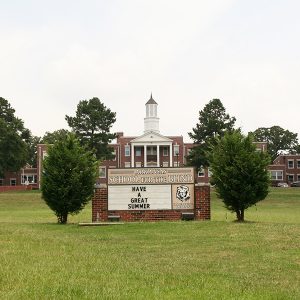calsfoundation@cals.org
Arkansas School for the Blind (ASB)
The Arkansas School for the Blind (ASB) in Little Rock (Pulaski County) teaches blind and visually impaired students to become productive citizens. The enriched curriculum, covering birth through age three and pre-kindergarten through the twelfth grade also offers a home-like setting to meet all students’ needs.
ASB was founded as the Institute for the Education of the Blind in 1859 by the Reverend Haucke, a blind Baptist minister. Otis Patten was the school’s first official superintendent. The campus was originally located in Arkadelphia (Clark County) but was moved to Little Rock in 1868, which made the school more accessible to students across the state. The first Little Rock campus was located at 1800 Center Street. The institute was renamed the Arkansas School for the Blind in 1877.
On October 9, 1939, the ASB campus was relocated to 2600 West Markham Street, where it remains today. Helen Keller spoke at the dedication, and the ASB administration building is named after her. The school had been moved because it needed room to expand as the student population increased.
In 1963, the school continued to expand by opening a facility for “multi-handicapped” students—students who had vision impairments as well as other disabilities. In 1971, ASB added a vocational curriculum to offer skills such as woodworking and computer technology. In 1976, the school began to provide additional statewide services including braille textbooks, large-print textbooks, and low-vision examinations to any blind or visually impaired students.
All teachers are certified in their core academic area, and they are also certified as teachers for the sensory impaired. If needed, teachers are given three years to become certified in that additional area. The academic program is accredited by both the Arkansas Department of Education (ADE) and the North Central Association.
ASB also has a variety of extracurricular activities such as athletics, instrumental music, art, and choir. Each class has its own adaptations for blind or visually impaired students. Other activities for students include sports such as wrestling, swimming, cheerleading, Special Olympics, and track. The ASB athletic teams compete against other schools for the blind as well as public school teams.
In addition to providing full academic, counseling, social skills training, and athletic programs, ASB also has several residential dormitories available that are managed by the Home Life area. These dorms are divided by gender as well as by grade level. Students are eligible for residential placement when their homes are located outside the area served by daily transportation. Transportation for residential students is provided each week.
The dorms provide an environment where students learn additional independence and social skills that are needed to interact equally with their peers in society. Some independence training activities include going to the movies or out to dinner, shopping at malls, or other various recreational activities. Skills taught in the dorms also include how to do laundry, housekeeping, and money management.
One of the newest programs at ASB is an early intervention program designed specifically to help children under the age of three who are visually impaired or blind. A new statewide Parent Resource Center was established in 2003 and is available to provide informational materials, training, and assistance to parents and family members of blind and visually impaired children throughout the state.
ASB also provides an expanded core curriculum for students who need intensive interventions. Specific areas may include braille, orientation and mobility, adaptive technology, daily living skills, and/or an area of academics, based on individual needs. A student may attend a few weeks or several months as needed—the intervention(s) last anywhere from a day to a semester or more. The ASB staff works with the student and the public school to determine the beginning date and length of the intensive intervention.
Students who are not currently legally blind may also qualify to attend ASB if their visual impairments have a negative impact on their education and social behavior or if they are facing the possibility of future vision loss. School-age students must be referred by their local school districts.
The Arkansas School for the Blind programs are funded by an appropriation through the Arkansas state legislature. In 2013, the total enrollment was ninety, with approximately eighty children statewide up to age three enrolled in the ASB early intervention program.
On February 14, 2023, Governor Sarah Huckabee Sanders announced plans for a new facility at the same location to serve students at both the ASB and the Arkansas School for the Deaf.
For additional information:
Arkansas School for the Blind. http://www.arkansasschoolfortheblind.org (accessed November 14, 2022).
Raney, Suzette. “The Evolution of the Arkansas Institute for the Blind.” Clark County Historical Journal (1983): 87–126.
Snyder, Josh. “Sanders Reveals Facility Plans.” Arkansas Democrat-Gazette, February 15, 2024, pp. 1B, 5B. Online at https://www.arkansasonline.com/news/2024/feb/14/sanders-announces-plans-for-new-state-of-the-art/ (accessed February 15, 2024).
Titan (Yearbook for the Arkansas School for the Blind). Butler Center for Arkansas Studies. Central Arkansas Library System, Little Rock, Arkansas. Online at https://cdm15728.contentdm.oclc.org/digital/collection/p15728coll3/search/searchterm/bc_book__arkblind*/order/date/ad/asc (accessed November 14, 2022).
Amy Craig, Brent McGehee, Joshua Nichols, Jessica Wilson
Leon Tidwell, Ann Moore, and Sharon Berry
Arkansas School for the Blind
 Arkansas School for the Blind
Arkansas School for the Blind  Arkansas School for the Blind
Arkansas School for the Blind  ASB Postcard
ASB Postcard  Arkansas School for the Blind
Arkansas School for the Blind 




Comments
No comments on this entry yet.